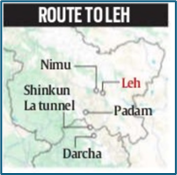Why in news?
While addressing a forum, External Affairs Minister S Jaishankar flagged that India has a “special China problem” which is over and above the world’s “general China problem”. In this context, he said that the border and the state of relations with the country call for investments from China to be scrutinised.
What’s in today’s article?
- India – China Border Dispute
- Border Roads Organisation (BRO) Infrastructure Projects on India-China Border
- Key highlights of the speech delivered by EAM
India – China Border Dispute
- Western Sector (Disputed sector) –
- This comprises the Aksai Chin sector. A region that originally was a part of the state of Jammu and Kashmir is claimed by China as part of its autonomous Xinjiang region.
- After the 1962 war, it is administered by China. It is the second largest Indo-China border area covering over 38000 sq. km. However, it is an uninhabited land.
- While India claims the entire Aksai Chin territory as well as the Shaksgam valley (Indian territory gifted to China by Pakistan), China contests Indian control over Daulat Beg Oldi (a tehsil in Leh, south of Aksai China - it is believed to host the world’s highest airstrip).
- Central Sector
- The 625 km boundary of this sector is least controversial between two nations.
- There is no major disagreement over boundary in this region between two countries.
- Border Dispute in Eastern Sector: McMahon Line
- The disputed boundary in the Eastern Sector of the India-China border is over the McMahon Line.
- Representatives of China, India and Tibet in 1913-14 met in Shimla to settle the boundary between Tibet and India, and Tibet and China.
- During the Shimla conference, Sir Henry McMahon, the then foreign secretary of British India, drew up the 890 km McMahon Line as the border between British India and Tibet.
- The McMahon line moved British control substantially northwards. This agreement ceded Tawang and other Tibetan areas to the imperial British Empire.
- Though the Chinese representatives at the meeting initialled the agreement, they subsequently refused to accept it.
- Subsequently, the Chinese government stated that it does not recognize the "illegal" McMahon Line.
- China accuses India of occupying areas in Arunachal, which it calls part of Southern Tibet.
- The Arunachal Pradesh border, that China claims to be its own territory, is the largest disputed area, covering around 90000 sq. km.
- During the 1962 war, the People’s Liberation Army occupied it but they announced a unilateral ceasefire and withdrew respecting the McMahon Line.
BRO Infrastructure Projects on India-China Border
- Road Infrastructure Completion:
- The BRO is nearing completion of specific road patches on an alternate route to Leh, ensuring all-weather connectivity.
- Key projects include connecting the Nimu-Padam-Darcha road and beginning work on the Shinku La tunnel, which will be the world’s highest tunnel at 15,800 feet.
- Leh Connectivity:
- There are currently three routes to Leh: via Srinagar-ZojiLa-Kargil, Manali-Rohtang, and the new Nimu-Padam-Darcha road.

- The Shinku La tunnel will significantly reduce the distance between Manali and Leh by 60 km, offering a third all-weather route.
- Ladakh Border Roads:
- The BRO prioritizes establishing connectivity to roads parallel to the Line of Actual Control (LAC) in eastern Ladakh, including the Leh-Demchok road and routes connecting Durbuk to Nyoma via Chushul.
- ICBR Programme:
- Under the India-China Border Roads (ICBR) programme, the BRO is focusing on completing strategic roads in Arunachal Pradesh and Ladakh, with a total of 73 strategic roads planned under the first two phases.
- Arunachal Pradesh Frontier Highway:
- A major project involves constructing a nearly 1,800-km frontier highway in Arunachal Pradesh, connecting various key locations close to the Myanmar border.
- Other Key Projects:
- The Sungal tunnel on the Akhnoor-Poonch National Highway and the Lipulekh Pass Road on the Mansarovar Yatra route are also priority projects for the BRO.
- Increased Focus Since 2020:
- Since 2020, there has been a significant acceleration in border infrastructure development in Ladakh and the Northeast, with increased budget allocations reflecting the importance of these projects for national security.
Key highlights of the speech delivered by EAM
- "Special China Problem" for India:
- India faces a unique set of challenges with China, distinct from the broader global concerns regarding China's rise.
- EAM emphasized that India's "special China problem" goes beyond the "general China problem" faced by other countries like the United States and those in Europe.
- Scrutiny of Chinese Investments:
- Given the strained border relations, India is justified in scrutinizing investments from China.
- Even countries without a border with China, such as the U.S. and European nations, are scrutinizing Chinese investments due to security concerns.
- Border Situation and Diplomatic Progress:
- Recent talks between India and China showed some diplomatic progress in resolving the border standoff, which began in May 2020.
- The phrase "narrow down the differences," used for the first time in these talks, indicates a positive development in negotiations.
- Trade Deficit and China's Unique Position:
- Jaishankar discussed the trade deficit with China, attributing it to China's unique production advantages that India and others failed to account for in the past.
- He stressed the need to understand China's unique political and economic system to formulate effective policies.
- Intersection of Economics and Security:
- The line between economics and national security is increasingly blurred, especially in the context of countries like China.
- National security now extends to areas like telecommunications, where reliance on Chinese technology could pose risks.
- Ongoing Border Standoff
- The border standoff between India and China has persisted for over four years, with significant troop deployments on both sides along the Line of Actual Control (LAC) in eastern Ladakh.
- While some friction points have been resolved, legacy issues in areas like Depsang Plains and Demchok remain.










